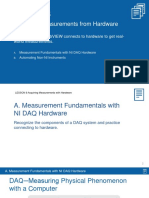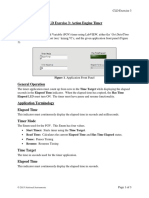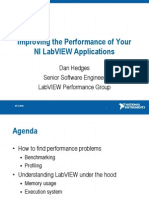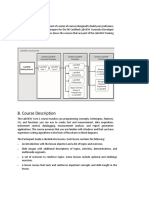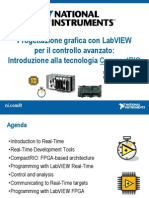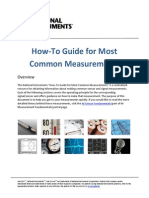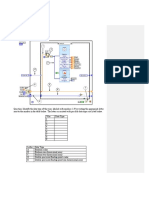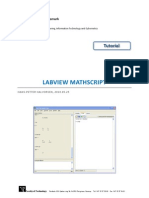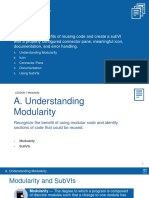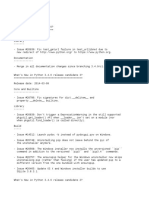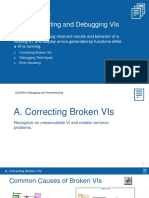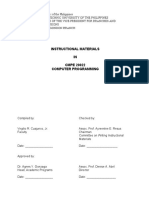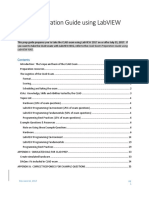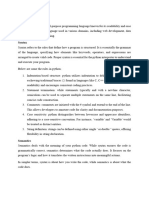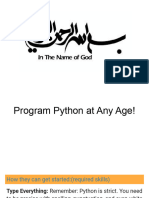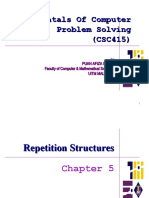Lesson 4
Using Loops
Recognize the different components of a LabVIEW loop
structure and apply a For Loop or a While Loop
appropriately
A. Loops Review D. Timing a VI
B. While Loops E. Data Feedback in Loops
C. For Loops F. Plotting Data
1
� LESSON 4 Using Loops
A. Loops Review
Recognize loop structures and explain how to use them.
• While Loops—Review
• For Loops—Review
• For Loop/While Loop Comparison
2
�A. Loops Review
While Loops—Review
3
�A. Loops Review
For Loops—Review
4
�A. Loops Review
For Loop/While Loop Comparison
5
�LESSON 4 Using Loops
Activity 4-1
While Loops vs. For Loops
Review four scenarios and determine the best type of loop to use for each one.
6
� LESSON 4 Using Loops
B. While Loops
Recognize tunnels and explain their purpose on a loop
structure and demonstrate how to use error checking and
error handling inside a loop.
• Tunnels
• Error Checking and Error Handling
7
�B. While Loops
Tunnels
8
�B. While Loops
Error Checking and Error Handling
Stop the While Loop if an error
occurs.
9
� LESSON 4 Using Loops
Exercise 4-1
Pass Data Through Tunnels
Use a While Loop and an iteration terminal and pass data through a tunnel.
10
� LESSON 4 Using Loops
Exercise 4-1
Pass Data Through Tunnels
How many times is the Number of Iterations indicator updated? Why?
Why do we include the Increment function?
11
� LESSON 4 Using Loops
C. For Loops
Demonstrate how to add a conditional terminal to a For Loop and
describe how numeric conversion occurs on the For Loop count
terminal.
• Conditional Terminal
• Count Terminal Numeric Conversion
12
�C. For Loops
Conditional Terminal
13
�C. For Loops
Count Terminal Numeric Conversion
14
� LESSON 4 Using Loops
D. Timing a VI
Identify scenarios that require loop timing and apply the
appropriate function.
• Reasons to Use Timing
• Wait Functions and Express VIs
15
�D. Timing a VI
Why do you need timing in a VI?
16
�D. Timing a VI
Wait Functions Inside a Loop
17
�D. Timing a VI
Wait Function Timing
18
�D. Timing a VI
Elapsed Time Express VI
19
�LESSON 4 Using Loops
Demonstration
Wait Chart VI
Compare and contrast using a Wait function and the Elapsed Time
Express VI for software timing.
20
� LESSON 4 Using Loops
E. Data Feedback in Loops
Apply shift registers when appropriate and predict the
correct value at different iterations of the loop.
• Introduction to Shift Registers
• Using Shift Registers
• Creating Shift Registers
21
�E. Data Feedback in Loops
Introduction to Shift Registers
22
� LESSON 4 Using Loops
Multimedia Module
Using Shift Registers
• Shift Registers • Default for Unwired Values
• Initializing Shift Registers • Compound Shift Registers
23
�LESSON 4 Using Loops
Demonstration
Creating Shift Registers
Create shift registers and convert existing tunnels to shift registers.
24
� LESSON 4 Using Loops
Exercise 4-2
Calculating Average
Temperature
Use a While Loop and shift registers to average data.
25
� LESSON 4 Using Loops
Exercise 4-2
Calculating Average
Temperature
You calculated the average of the last 5 temperature readings. How would you
modify the VI to calculate the average of the last 10 temperature readings?
26
� LESSON 4 Using Loops
F. Plotting Data
Use data feedback in a loop to plot waveform charts.
• Waveform Chart
• Waveform Chart Properties
27
�F. Plotting Data
Waveform Chart
28
�F. Plotting Data
Waveform Chart Properties
29
� LESSON 4 Using Loops
Exercise 4-3
Temperature Monitor VI—Plot
Multiple Temperatures
Plot multiple data sets on a single waveform chart and customize the chart
view.
30
� LESSON 4 Using Loops
Exercise 4-3
Temperature Monitor VI—Plot
Multiple Temperatures
In what ways do the following tools allow the user to interact with the plot?
• Plot Legend
• Graph Palette
• Scale Legend
31
�LESSON 4 Using Loops
Activity 4-2
Lesson Review
Refer to the participant guide to answer questions about what you have learned
in this lesson and then discuss the answers as a group.
32
�Lesson Review
1. Which structure must run at least one
time?
a. For Loop
b. While Loop
33
�Lesson Review
1. Which structure must run at least one
time?
a. For Loop
b. While Loop
34



